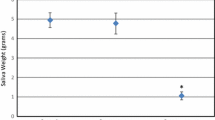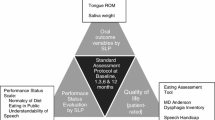Abstract
Purpose
The aim of this study was to investigate the feasibility of tongue strength measures (TSMs) and the influence of bulb location, sex, and self-perceived pain and mucositis in head and neck cancer (HNC) patients during chemoradiotherapy (CRT).
Methods
Twenty-six newly diagnosed HNC patients treated with CRT performed anterior and posterior maximal isometric tongue pressures by means of the Iowa Oral Performance Instrument (IOPI). The Oral Mucositis Weekly Questionnaire (OMWQ) and a Visual Analogue Scale (VAS) for pain during swallowing were completed weekly from baseline to 1 week post CRT.
Results
Feasibility of TSMs during CRT declines significantly from 96 to 100% at baseline to 46% after 6 weeks of CRT. But post-hoc analyses reveal only significant differences in feasibility between baseline and measurements after 4 weeks of treatment. No effect of gender or bulb location was established, but feasibility is influenced by pain and mucositis.
Conclusions
Feasibility of TSMs declines during CRT and is influenced by mucositis and pain. For the majority of subjects, TSMs were feasible within the first 4 weeks, which provides a window of scientific and clinical opportunities in this patient population.





Similar content being viewed by others
References
Lazarus CL, Husaini H, Falciglia M, DeLacure RC, Branski D, Kraus D, Lee N, Ho M, Ganz C, Sith B, Sanfilippo N (2014) Effect s of exercise on swallowing and tongue strength in patients with oral and oropharyngeal cancer treated with primary radiotherapy with or without chemotherapy. Int J Oral Maxillofac Surg 43(5):523–530. doi:10.1016/j.ijom.2013.10.023
Pignon JP, le Maîre A, Maillard E, Bourhis J, MACH-NC Collaborative Group (2009) Meta-analysis of chemotherapy in head and neck cancer (MACH-NC) : an update on 93 randomised trials and 17,346 patients. Radiother Oncol 92(1):4–14. doi:10.1016/j.radonc.2009.04.014
Lefebvre JL, Chevalier D, Luboinski B, Kirkpatrick A, Collette L, Sahmoud T (1996) Larynx preservation in pyriform sinus cancer: preliminary results of a European Organization for Research and Treatment of Cancer phase III trial. EORTC Head and Neck Cancer Cooperative Group. J Natl Cancer Inst 88:890–899
Forastiere AA, Goepfert H, Maor M, Pajak TF, Weber R, Morrison W, Glisson B, Trotti A, Ridge JA, Chao C, Peters G, Lee DJ, Leaf A, Ensley J, Cooper J (2003) Concurrent chemotherapy and radiotherapy for organ preservation in advanced laryngeal cancer. New Engl J Med 349:2091–2098
Maurer J, Hipp M, Schäfer C, Kölbl O (2010) Dysphagia. Impact on quality of life after radio(chemo)therapy of head and neck cancer. Strahlenther Onkol 11:744–749. doi:10.1007/s00066-011-2275-x
Raber-Durlacher JE, Brennan MT, Verdonck-de Leeuw IM, Gibson RJ, Eilers JG, Waltimo T, Bots CP, Michelet M, Sollecito TP, Rouleau TS, Sewnaik A, Bensadoun R-J, Fliedner MC, Silverman S Jr, Spijkervet FKL, Dysphagia Section, Oral Care Study Group, Multinational Association of Supportive Care in Cancer (MASCC)/International Society of Oral Oncology (ISOO) (2010) Swallowing dysfunction in cancer patients. Support Care Cancer 20:433–443. doi:10.1007/s00520-011-1342-2
Langendijk JA, Doornaert P, Verdonck-de Leeuw IM, Leemans CR, Aaronson NK, Slotman BJ (2008) Impact of late treatment-related toxicity on quality of life among patients with head and neck cancer treated with radiotherapy. J Clin Oncol 26(22):3770–3776. doi:10.1200/JCO.2007.14.6647
Szcesniak MM, Maclean J, Zhang T, Graham PH, Cook IJ (2014) Persistant dysphagia after head and neck radiotherapy: a common and under-reported complication with significant effect on non-cancer-related mortality. Clin Oncol 26:697–703. doi:10.1016/j.clon.2014.08.009
Tedla M, Valach M, Carrau RL, Varga I, Profant M, Mráz P, Weismann P (2012) Impact of radiotherapy on laryngeal intrinsic muscles. Eur Arch of Otorhinolaryngol 169(3):953–658. doi:10.1007/s00405-011-1686-8
Hutcheson KA, Lewin JS, Barringer DA, Lisec A, Gunn B, Moore MWS, Holsinger FC (2012) Late dysphagia after radiotherapy-based treatment of head and neck cancer. Cancer 118(23):5796–5799. doi:10.1002/cncr.27631
De Bodt M, Guns C, D’Hondt M, Vanderwegen J, Van Nuffelen G (2015) Dysfagie. Handboek voor de klinische praktijk. Garant, Antwerpen
List MA, Siston A, Haraf D (1999) Quality of life and performance in advanced head and neck cancer patients on concomitant chemoradiotherapy: a prospective examination. J Clin Oncol 17:1020–1028
Nund RL, Scarinci NA, Cartmill B, Ward EC, Kuipers P, Porceddu SV (2014) Application of the international classification of functioning, disability and health (ICF) to people with dysphagia following non-surgical head and neck cancer management. Dysphagia 29(6):692–793. doi:10.1007/s00455-014-9563-4
Murphy BA, Deng J (2015) Advances in supportive care for late effects of head and neck cancer. Journal of clinical oncology 33(29):3314–3321. doi:10.1200/JCO.2015.61.3836
King SN, Dunlap NE, Tennant PA, Pitts T (2016) Pathophysiology of radiation-induced dysphagia in head and neck cancer. Dysphagia 31(3):339–351. doi:10.1007/s00455-016-9710-1
Rosenthal D, Lewin J, Eisbruch A (2006) Prevention and treatment of dysphagia and aspiration after chemoradiation for head and neck cancer. J Clin Oncol 24:2636–2643
Virani A, Kunduk M, Fink DS (2015) Effects of 2 different swallowing exercise regimens during organ-preservation therapies for head and neck cancers on swallowing function. Head Neck 37(2):162–170. doi:10.1002/hed.23570
Kulbersh BD, Rosenthal EL, McGrew BM, Duncan RD, McColloch NL, Carroll WR, Magnuson JS (2006) Pretreatment, preoperative swallowing exercises may improve dysphagia quality of life. Laryngoscope 116(6):883–886. doi:10.1097/01.mlg.0000217278.96901.fc
Duarte VM, Chhetri DK, Liu YF, Erman AA, Wang MB (2013) Swallow preservation exercises during chemoradiation therapy maintains swallow function. Otolaryngol Head Neck Surg 149(6):878–884. doi:10.1177/0194599813502310
Van der Molen L, Van Rossum MA, Burkhead LM, Smeele LE, Rasch CRN, Hilgers FJM (2011) A randomized preventive rehabilitation trial in advanced head and neck cancer patients treated wih chemoradiotherapy: feasibility, compliance, and short-term effects. Dysphagia 26:155–170. doi:10.1007/s00455-010-9288-y
Carnaby-Mann G, Crary MA, Schmalfuss I, Amdur R (2012) "Pharyngocise": randomized controlled trial of preventative exercises to maintain muscle structure and swallowing function during head-and-neck chemoradiotherapy. Int J Radiat Oncol Biol Phys 83(1):210–219. doi:10.1016/j.ijrobp.2011.06.1954
Schindler A, Denaro N, Russi EG, Pizzorni N, Bossi P, Merlotti A, Spadola Bissetti M, Numico G, Gava A, Orlandi E, Caspiani O, Buglione M, Alterio D, Bacigalupo A, De Sanctis V, Pavanato G, Ripamonti C, Merlano MC, Licitra L, Sanquineti G, Langendijk JA, Murphy B (2015) Dysphagia in head and neck cancer patients treated with radiotherapy and systemic therapies: literature review and consensus. Crit Rev Oncol Hematol 96(2):372–384. doi:10.1016/j.critrevonc.2015.06.005
Lazarus CL, Logemann JA, Pauloski BR (2007) Effects of radiotherapy with or without chemotherapy on tongue strength and swallowing in patients with oral cancer. Head Neck 29:632–637
Lazarus CL, Logemann JA, Pauloski BR (2000) Swallowing and tongue function following treatment for oral and oropharyngeal cancer. J Speech Lang Hear Res 43:1011–1023
Butler SG, Stuart A, Leng X, Wilhelm E, Rees C, Williamson J, Kritchevsky SB (2011) The relationship of aspiration status with tongue and handgrip strength in healthy older adults. J Gerontol A Biol Sci Med Sci 66(4):452–458. doi:10.1093/gerona/glq234
Ku PK, Yuen EH, Cheung DM, Chan BY, Ahuja A, Leung SF, Tong MC, van Hasselt A (2007) Early swallowing problems in a cohort of patients with nasopharyngeal carcinoma: symptomatology and videofluoroscopic findings. Laryngoscope 117(1):142–146
Smith RV, Kotz T, Beitler JJ, Wadler S (2000) Long-term swallowing problems after organ preservation therapy with concomitant radiation therapy and intravenous hydroxyuera: initial results. Arch Otolaryngol Head Neck Surg 126(3):384–389
Iowa Oral Performance Instrument. http://www.iopimedical.com Accessed 14th April 2016.
Vanderwegen J, Guns C, Van Nuffelen G, Elen R, De Bodt M (2013) The influence of age, sex, bulb position, visual feedback, and the order of testing on maximum anterior and posterior tongue strength and endurance in healthy Belgian adults. Dysphagia 2:159–166. doi:10.1007/s00455-012-9425-x
Oh DH, Park JS, Jo YM, Chang M (2016) Differences in maximal isometric tongue strength and endurance of healthy young vs. older adults. J Phys Ther Sci 3:854–856. doi:10.1589/jpts.28.854
Mendes AE, Nascimento L, Mansur LL, Callegaro D, Jacob Filho W (2015) Tongue forces and handgrip strength in normal individuals: association with swallowing. Clinics 70(1):41–45. doi:10.6061/clinics/2015(01)08
Todd JT, Lintzenich CR, Butler SG (2013) Isometric and swallowing tongue strength in healthy adults. Laryngoscope 123(10):2469–2473. doi:10.1002/lary.23852
De Sanctis V, Bossi P, Sanguineti G, Trippa F, Ferrari D, Bacigalupo A, Ripamonti CI, Buglione M, Pergolizzi S, Langendijk JA, Murphy B, Raber-Durlacher J, Russi EG, Lalla RV (2016) Mucostis in head and neck cancer patients treated with radiotherapy and systemtic therapies: literature review and consensus statements. Crit Rev Oncol Hematol 100:147–166. doi:10.1016/j.critrevonc.2016.01.010
Mercadante S, Ajelli F, Adile C, Ferrera P, Valle A, Fusco F, Caruselli A, Cartoni C, Massimo P, Masedu F, Valenti M, Porzio G (2015) Prevalence of oral mucositis, dry mouth, and dysphagia in advanced cancer patients. Support Care Cancer 23(11):3249–3255. doi:10.1007/s00520-015-2720-y
Van Nuffelen G, Van den Steen L, Vanderveken O, Specenier P, Van Laer C, Van Rompaey D, Guns C, Mariën S, Peeters M, Van de Heyning P, Vanderwegen J, De Bodt M (2015) Study protocol for a randomized controlled trial: tongue strengthening exercises in head and neck cancer patients, does exercise load matter? Trials 4(16):395. doi:10.1186/s13063-015-0889-5
Epstein JB, Beaumont JL, Gwede CK, Murphy B, Garden A, Meredith R, Le QT, Brizel D, Isitt J, Cella D (2007) Longitudinal evaluation of the oral mucositis weekly questionnaire-head and neck cancer, a patient-reported outcomes questionnaire. Cancer 109(9):1–9
Holm S (1979) A simple sequentially rejective multiple test procedure. Scand J Stat 6(2):65–70
Britton B, Mc Carter K, Baker A, Wolfenden L, Wratten C, Bauer J, Beck A, Mc Elduff P, Halpin S, Carter G (2015) Eating eating as treatment (EAT) study protocol: a stepped wedge, randomised controlled trial of health behaviour change intervention provided by dietitians to improve nutrition in patients with head and neck cancer undergoing radiotherapy. BMJ Open 5(7):e008921. doi:10.1136/bmjopen-2015-008921
Acknowledgements
This work was funded by Belgian Federal Cancer Plan (KPC29_033).
We thank all researchers from the KP-study group, the patients, their families, and caregivers.
Author information
Authors and Affiliations
Consortia
Corresponding author
Ethics declarations
Conflict of interest
Mrs. Van den Steen reports grants from Belgian Federal Cancer Plan (KPC29_033) during the conduct of the study.
Rights and permissions
About this article
Cite this article
Van den Steen, L., Vanderveken, O., Vanderwegen, J. et al. Feasibility of tongue strength measurements during (chemo)radiotherapy in head and neck cancer patients. Support Care Cancer 25, 3417–3423 (2017). https://doi.org/10.1007/s00520-017-3761-1
Received:
Accepted:
Published:
Issue Date:
DOI: https://doi.org/10.1007/s00520-017-3761-1




